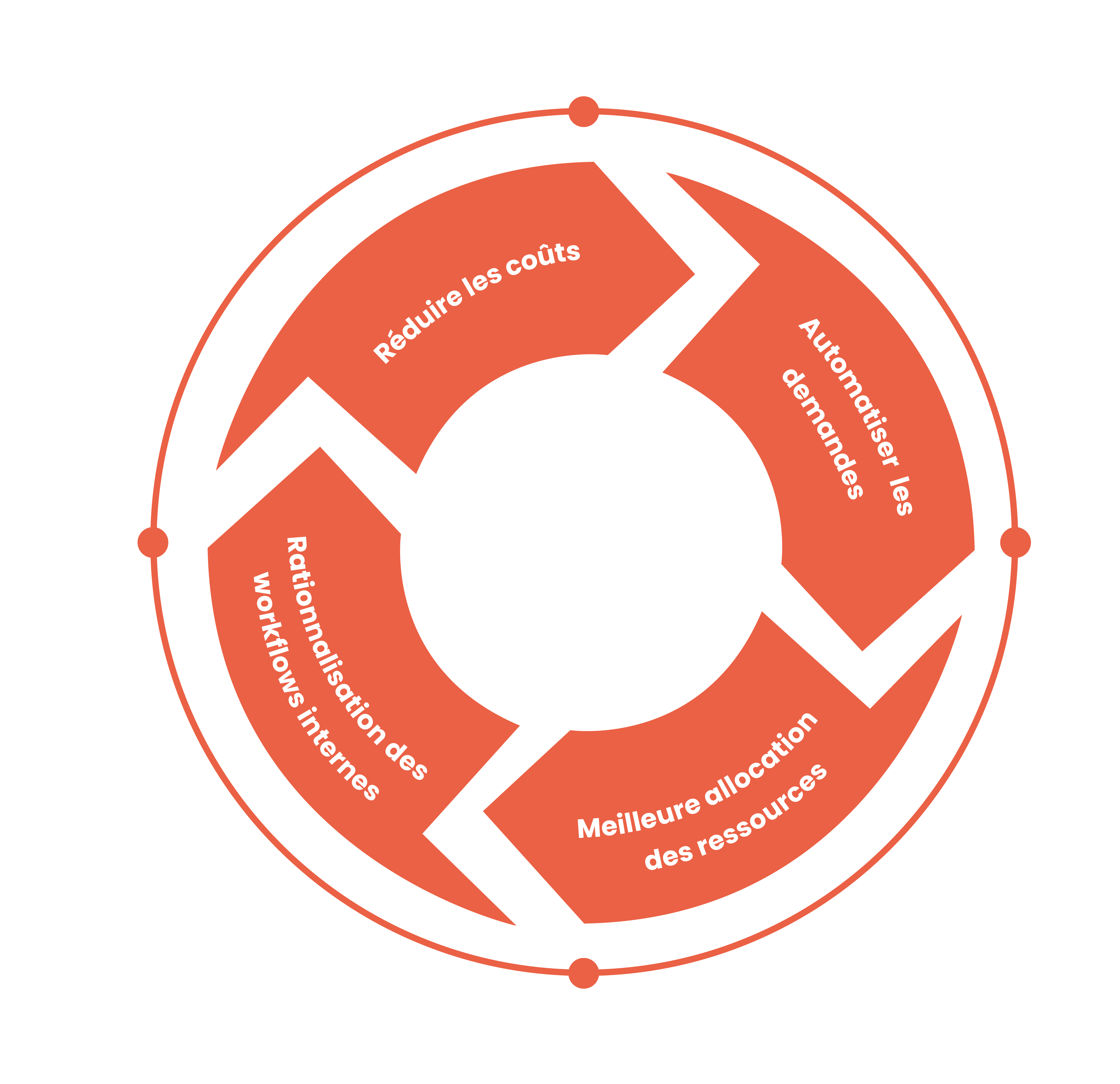Losing a customer is a clear warning sign. It often shows that the relationship could have used more attention. Today, customer experience is just as important as the product or service itself. Customer satisfaction, once seen as a simple operational metric, has become a key strategic focus. It’s now regularly reviewed at the highest levels of companies, even by executive committees. Satisfaction reflects the quality customers perceive, the efficiency of your services, and how attached people feel to your brand. Yet many customers still feel like they’re just a number. To change that, it’s essential to personalize every interaction, make communication easier, and truly listen to what customers say. This is where artificial intelligence (AI) becomes a powerful tool. By making services faster, smarter, and more human, AI is transforming customer relationship management.
Explore our guide on using AI in customer service, and see how this technology can improve the experience for your business, your customers, and your teams.

Customer relationship includes all the practices, strategies, and technologies that companies use to manage and improve interactions with current and potential customers. It follows a customer-centric approach, aiming to better understand customer needs, anticipate expectations, and provide a smooth, consistent, and engaging experience. In contrast, customer service focuses on specific situations responding to a request or solving a particular problem.
Customer relationship also includes the emotions and perceptions a client feels throughout their journey with a company before, during, and after a purchase. It depends not only on the quality of the product or service, but also on the quality of interactions with the company’s teams. Every touchpoint, even a small one, can strengthen or weaken the brand image. According to Salesforce, 88% of consumers say the experience matters as much as the product. That’s why customer experience management should be seen as an ongoing process, fully integrated into the company’s overall strategy. The goal is to build long-term trust through personalized and relevant interactions. This requires clear communication, quick responses, and solutions tailored to each situation. All employees must be aligned around shared goals to ensure a consistent customer experience.
In the digital age, technology plays a key role in this effort. CRM platforms, AI-powered customer chatbots, and predictive analytics help automate tasks, better target needs, and deliver a faster, more personalized, and more human experience.
By integrating these AI tools into their customer relationship strategies, companies can boost customer satisfaction and loyalty, while strengthening their competitive edge with a more innovative and distinctive experience.
In a context where consumer expectations are rapidly evolving, the quality of customer relationships has become a real performance driver. Here are the three main challenges of customer relationship management:

Customer satisfaction: meeting customer expectations effectively is key to building satisfaction and loyalty. A satisfaction-focused approach involves careful listening, tailored responses, and anticipating needs. However, customer relations are often pushed to the background, seen as time-consuming and low-value. Yet when integrated across all teams, it becomes a powerful growth driver. A smooth and positive experience helps attract new prospects and build loyalty by offering the right responses through the right channels. A satisfied customer is more likely to recommend a brand and stay loyal over the long term.
Loyalty: strong interactions encourage customers to return, which helps reduce acquisition costs. Today, consumer behavior is shifting, and companies must adapt by diversifying their communication channels. These may include physical stores, emails, phone calls, chatbots, social media, or customer reviews. Being able to communicate effectively across these channels strengthens brand attachment. Well-designed loyalty programs, efficient after-sales service, and personalized interactions also help build lasting engagement.
Competitive advantage: excellent customer support can set a company apart from its competitors. While some still overlook this lever, others treat it as a key strategic element. By carefully analyzing customer interactions and adjusting actions based on feedback, businesses can fine-tune their positioning and strengthen their competitiveness. Delivering high-quality customer experiences is a way to stand out over time and to establish strong trust with consumers. Companies that prioritize customer satisfaction enjoy a better reputation and benefit from positive word of mouth, both essential for sustainable growth.
According to a 2023 Odoxa study for Kiamo (“The French and Customer Service in the Face of Artificial Intelligence”), only 56% of French consumers say they feel well treated when contacting customer service, and 62% report frustration with wait times. This highlights the urgent need to rethink how customer service is organized so it can be more responsive, accessible, and attentive to customer expectations.
In an environment where every interaction matters, building a high-quality customer relationship has become a key strategic lever. Here are the essential pillars to optimize:

Understanding customers’ needs and expectations is essential for building a strong relationship. This requires attentive listening, but also the implementation of appropriate communication channels that allow customers to express themselves freely. Active listening goes beyond simply hearing requests; it involves the ability to detect subtle cues such as hesitation, unspoken concerns, or frustration.
Customer satisfaction surveys, review analysis, and interactions on social media provide key insights into consumers’ deeper expectations. When integrated into a broader strategy, this data helps refine offerings, optimize services, and make interactions more relevant.
It reassures customers and strengthens their feeling of being understood. Tools such as online questionnaires, feedback sessions, or automated sentiment and emotion analysis help structure this dialogue in a continuous and constructive way, while also anticipating future needs.
Adapting services and communication to each customer’s preferences and behavior strengthens their sense of being valued and recognized. Today, consumers expect tailored interactions, and the companies that succeed are those that manage to deliver highly personalized experiences.
With customer data and customer relationship management (CRM) tools, it’s possible to send targeted recommendations, customize the buying journey, and provide more personalized responses. A proactive approach such as sending reminders, birthday emails with special offers, or promotions tailored to individual needs helps build a closer connection with the brand.
In addition, the integration of personalized content into interactions (like explainer videos, user guides, or tailored advice) not only strengthens brand loyalty but also enhances the overall user experience.
Customers value quick and relevant responses to their requests. In a world where instant communication is the norm, a company’s responsiveness strongly influences how the brand is perceived and how loyal customers remain.
Providing multiple communication channels such as customer chatbots, interactive FAQs, phone support, and social media ensures quick replies and continuous assistance. Some companies also manage expectations by informing customers of average response times and offering alternative solutions while they wait.
Automating certain tasks with AI agents helps streamline the handling of repetitive queries, freeing up time for human advisors. It is essential, however, that these solutions remain accessible and transparent to avoid frustrating the customer. Combining automated assistance with optimized human intervention helps strike a balance between efficiency and satisfaction.
Responsiveness also involves anticipation. By analyzing behavior and recurring questions, companies can improve internal processes and offer solutions before the customer even asks. Providing effective self-service tools helps improve the customer experience while reducing the workload on support teams.

Artificial intelligence (AI) refers to all technologies capable of simulating human cognitive functions, such as natural language understanding, learning, or problem-solving. Thanks to recent advances in data processing, AI has become a key player in many sectors and customer relations are no exception.
The rise of generative AI marks a new milestone in the evolution of customer relationships. It enables more natural interactions using everyday language and opens the door to a growing variety of use cases, from automated support to proactive generation of personalized content. At first, AI integration into customer experience focused on automating simple tasks, such as sorting requests or answering frequently asked questions. But it quickly went further. Personalized communication, need anticipation, and improved response times have become expected standards.
By helping companies better understand customer behavior and optimize their resources, AI does more than simplify customer satisfaction, it reinvents it. With its ability to analyze at scale and continuously adapt interactions, AI becomes a strategic asset for creating experiences that are more relevant, seamless, and engaging.
At the same time, new systems now allow certain LLMs to evaluate other AIs, following the "LLM as a judge" principle. This evaluation capability paves the way for trustworthy AI, where automated decisions can be supervised, corrected, and controlled, reinforcing the reliability and ethics of interactions between companies and their customers.
According to HubSpot, 72% of sales professionals using AI say it helps them build trust with customers more quickly.
Chatbots and AI agents are intelligent conversational interfaces that automate first-line customer interactions. They can handle a high volume of simultaneous requests and deliver instant, consistent, and contextual responses. Using machine learning and natural language processing (NLP) algorithms, they continuously improve by learning from past conversations. This enhances their ability to understand user intent and deliver increasingly personalized responses.
Visual IVR is an evolution of the traditional Interactive Voice Response system. It enriches the user experience by displaying guided journeys directly on a smartphone or browser. This reduces cognitive load and navigation errors, while making access to services smoother. It fits perfectly within an advanced self-care strategy, allowing customers to resolve issues without human assistance while keeping the option to escalate to an advisor when needed.
CRM (Customer Relationship Management) tools, such as Salesforce, have become intelligent hubs for customer data. By centralizing interaction history, preferences, and buying behavior, they enable advanced behavioral segmentation and seamless omnichannel service orchestration. When integrated with AI modules, these systems can also provide predictive churn scores, tailored recommendations, or proactive alerts for customer service agents.
Omnichannel engagement platforms make it possible to manage all customer interactions in real time across every channel (email, phone, chat, social media, instant messaging) from a single unified interface. This ensures a smooth, consistent, and seamless experience, with full traceability of each exchange. When combined with AI tools, these platforms can prioritize requests, analyze emotions expressed in messages, and route conversations to the most relevant customer service agent.
Automation tools and proactive communication systems such as mailbots, sequencers, and smart notifications automatically send targeted messages based on customer behavior, journey stage, or specific triggers (upcoming renewal, inactivity, policy changes, etc.). These technologies help maintain regular contact with customers, anticipate their needs, and trigger personalized actions at the right time without human intervention. Paired with scoring tools or CRM systems, mailbots can orchestrate large-scale customer engagement campaigns while preserving a personal touch.
Intelligent voice assistants like voicebots handle voice requests through incoming calls or voice interfaces. Using natural language processing (NLP) and speech recognition, voicebots can answer simple questions, guide users through dynamic voice menus, or redirect them to the right contact person. They offer a modern alternative to traditional IVR systems, reduce wait times, improve service accessibility, and provide a smoother experience on channels that are still widely used especially phone calls.
Feedback and sentiment analysis tools combine real-time surveys, customer reviews, and semantic analysis to enable large-scale customer listening. Automated processing of open-ended feedback using AI makes it possible to identify recurring pain points, measure satisfaction in real time (NPS, CSAT, CES), and continuously adjust processes. Some tools even offer automated action plans based on customer feedback flagged as critical.
AI first helps reduce operational costs by automating routine requests, freeing up customer service agents to focus on more complex, high-value tasks. This automation enables better resource allocation, a more agile organization, and streamlined internal workflows.

It also improves operational efficiency by handling repetitive and time-consuming tasks, which reduces processing times and human errors. As a result, customer service agents become more productive and can focus on more rewarding tasks, increasing their engagement. This efficiency is especially evident in an omnichannel approach, where AI helps centralize and synchronize interactions across all channels (phone, email, chat, social media). The customer benefits from a seamless journey, with no breaks between touchpoints, which strengthens consistency and overall experience quality.
To learn more, download our white paper Customer Excellence and Omnichannel Orchestration: a strategic guide to transforming your customer relationships through integrated, seamless, and high-performing journeys.
By enabling service continuity, AI also makes it possible to handle a high volume of simultaneous requests across all channels, ensuring smooth and consistent support regardless of the contact method used. This ability to maintain a steady level of quality directly helps increase customer satisfaction, especially through instant, 24/7 responses, which significantly reduce wait times and improve overall service perception.
At the same time, AI enables highly personalized interactions by using customer data to tailor offers, recommendations, and messages to each profile. It also helps anticipate customer needs through predictive analytics, making interactions more relevant and proactive.
Some AI systems can also support agents in real time by providing contextual information and suggested actions, improving first-contact resolution. In this case, the agent is said to be "augmented" by AI tools. In addition, with machine learning, AI continually improves its performance and responses over time through ongoing interactions.
These many benefits make AI a powerful strategic lever for building a customer relationship that is more efficient, personalized, responsive, and focused on long-term satisfaction.
During periods of high tension or crisis, maintaining customer service continuity becomes a strategic priority. Many organizations turn to digital solutions, especially visual IVR, to reduce call center overload and guide customer requests more efficiently. This type of automated interface allows users to quickly access answers without human intervention, while still offering the option to escalate to an advisor.
In the public or healthcare sectors, the deployment of online appointment systems, teleconsultation platforms, or interactive forms has improved access to essential services. These tools promote greater user autonomy and faster response times when faced with high volumes of requests.
Example: The French Ministry of Solidarity and Health used DialOnce’s visual IVR solution during the Covid-19 crisis to direct calls to the appropriate information channels, achieving maximum reachability, with 100% of calls handled.
The social housing sector is also transforming its relationship with residents through AI. To respond to a growing number of requests while maintaining high-quality human support, social housing providers are now integrating conversational AI agents capable of handling simple and recurring tenant queries.
This is the case for 1001 Vies Habitat, which implemented a conversational AI agent to streamline communication with its tenants. The tool provides instant 24/7 answers on topics such as administrative procedures, maintenance requests, or contact information. The result: significantly improved service availability and better distribution of requests across dedicated teams.
The banking sector and the insurance industry are turning to digital tools to improve the quality of customer support, in a context where expectations for speed, simplicity, and security continue to rise. These institutions are increasingly adopting AI agents, virtual assistants, and smart automation tools to efficiently handle simple requests and guide customers to the right person when human support is needed.
In banking, the benefits are already clear. For example, Crédit Agricole Nord-de-France implemented a visual IVR solution with DialOnce to better manage incoming calls. The results include a 25% reduction in repeated calls, 3,500 hours of productivity gained, and a significant improvement in reachability, all without compromising customer experience quality.
In insurance, digital solutions have helped clarify and streamline the journey from the very first point of contact. Automating the reception and routing of requests reduces wait times and eases the workload on advisors. This is the case for GMF, which deployed a visual IVR to simplify the initial interaction. As a result, 84% of users reported satisfaction with the new process, and the number of calls transferred to advisors dropped by 20%.
In the travel industry, the ability to deliver responsive, multilingual, and personalized customer service is a key differentiator. Companies in this sector rely on automated interfaces to support customers from the booking stage through to post-trip feedback.
With AI agents, behavioral analytics, and real-time notifications, professionals can anticipate needs, provide reassurance in case of unexpected events (such as delays or flight changes), and enhance the overall experience with content and services tailored to the traveler’s profile.
Example: The website Lastminute.com uses an automated support solution to manage requests for booking changes or cancellations, significantly easing the burden on its customer service teams.

Integrating artificial intelligence into customer relationship systems offers a strong opportunity to rethink customer journeys and increase agility. Far from being an obstacle, this technological shift allows companies to intelligently connect their tools (CRM, contact centers, IVR systems, omnichannel platforms, etc.) and build a unified view of the customer. Close collaboration between IT and customer management teams, supported by testing phases and targeted training, ensures smooth adoption and helps employees gradually build new skills.
Another key consideration is the balance between automation and human intervention. While AI can relieve pressure on contact centers, it cannot handle every request with the same level of empathy or judgment as a human agent. Preserving a human touch, especially for complex cases is essential to maintaining service quality and ensuring customer satisfaction.
In an increasingly demanding digital environment, data security is a central concern for all businesses. Managing sensitive data, especially personal information, remains a top priority. Any failure in how this data is processed or stored can compromise user trust and damage an organization’s reputation. To meet these expectations, it is essential to implement robust encryption systems, enhanced authentication, and access control, while also complying with current regulations such as GDPR or HIPAA in the most sensitive industries. The integration of digital solutions, including those powered by AI, must go hand in hand with strong safeguards for data protection and governance.
Finally, the risk of hallucinations (the generation of incorrect or inconsistent content) reminds us that generative AI is not infallible. To reduce these risks, several complementary actions are essential: maintaining active human oversight, training models on reliable data, and regularly monitoring their performance over time.
A particularly promising approach already exists: LLM as a judge. The idea is simple, using one AI system to evaluate the output of another, especially to verify the quality and consistency of generated responses. This introduces a form of automated oversight and helps make AI usage more reliable. It is a meaningful step toward more controlled, transparent, and trustworthy AI.
Integrating artificial intelligence into customer relationship management aims to enhance the user experience, streamline interactions, and increase operational efficiency. To assess the real impact of these technologies, it is essential to track relevant key performance indicators (KPIs). Below are the main KPIs used to measure the effectiveness of AI:

Measuring the effectiveness of artificial intelligence goes beyond technical gains. It also involves assessing the real impact on customer relationship quality, user satisfaction, and overall team efficiency. By combining quantitative data with qualitative feedback, companies can fine-tune and continuously optimize their AI-driven customer strategy.
New indicators are now enriching this evaluation process, particularly through the LLM as a judge approach. One AI system can now evaluate the work of another by analyzing the relevance of generated responses using criteria such as the ability to resolve a request, perceived satisfaction, or alignment with expected information. This represents a major step forward toward systems that are more reliable, transparent, and truly focused on user needs.
The integration of artificial intelligence into customer relationship management is still in its early stages. While AI agents and tools are now well embedded in service strategies, the next generation of AI will profoundly transform the way companies interact with their customers. In the near future, AI will no longer just respond to requests, it will co-pilot the entire customer journey, from intent detection to post-purchase support. Conversational models will include advanced cognitive capabilities, such as emotional understanding and real-time context analysis. This level of hyper-contextualization will pave the way for truly proactive customer relationships, capable of anticipating needs and initiating interactions before the customer even makes a request.
Within this shift, agentic AI will play a key role. AI will no longer act as a simple assistant, but as an autonomous agent, able to make decisions, take initiative, and collaborate with other intelligences to complete tasks. Multi-agent systems will make it possible to coordinate several specialized AI, each assigned to a specific task such as order management, support, or recommendation, working together to deliver a seamless, coordinated experience.
In addition, AI systems will become increasingly interconnected with business tools (ERP, CRM, logistics platforms, payment services), enabling end-to-end, real-time request resolution with no break in the journey. This concept of "augmented service" will transform contact centers into experience control hubs, where human agents will step in only for high-value relational interactions. In this context, the main challenge will no longer be only technological, but also organizational and cultural. It will require rethinking team roles, reallocating resources toward strategic functions, and building robust, ethical data governance.
To succeed in this transformation, it is essential to rely on a trusted partner with dual expertise: both technological and industry-specific. A specialized provider like DialOnce can not only configure the tools with precision, but also support changes in usage, train teams, and ensure ongoing compliance with regulatory requirements.
Anticipating this new era of customer relationships means investing in a long-term AI strategy, one that is guided, measurable, and human-centered. It is this alliance between artificial intelligence and business intelligence that will enable companies to create a truly distinctive and sustainable customer experience.